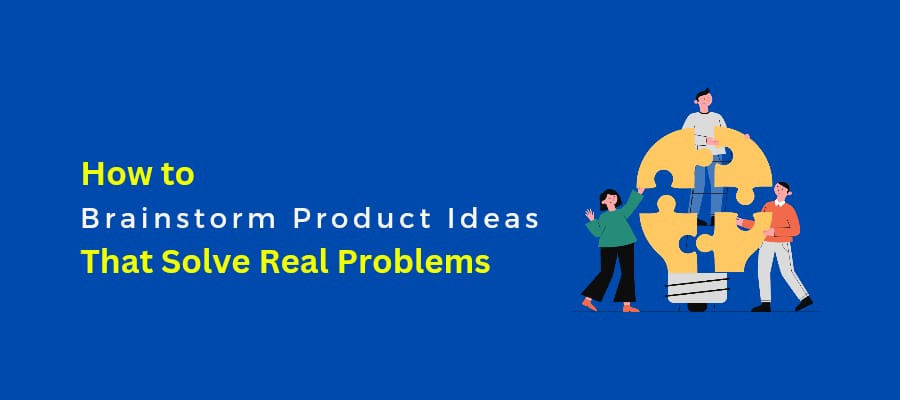How To Brainstorm Product Ideas That Solve Real Problems

When developing a product that makes a difference, it's all about solving real problems. But how do you deliver a brilliant solution without reporting a single issue? That’s where brainstorming comes in—a powerful technique for harnessing collective creativity and turning it into practical, innovative ideas.
In this article, we’ll dive into how you can effectively brainstorm product ideas that hit the mark and resonate with your audience. We’ll explore different brainstorming methods and tips to make your ideation process smoother and more productive.
Why Brainstorming is Essential for Product Development?
Product development isn’t just about creating something new—it’s about building something valuable. The process starts with understanding the problem you're trying to solve. This understanding forms the foundation for brainstorming sessions, where teams gather to generate ideas that address the core issue.
Brainstorming is crucial because it allows you to explore a wide range of possibilities in a short amount of time. It encourages open dialogue, sparks creativity, and helps you think outside the box. However, it’s not just about throwing ideas around—structured brainstorming can lead to innovative solutions that align with your product vision and customer needs.
Steps to a Successful Brainstorming Session
A successful brainstorming session doesn’t happen by accident. It requires preparation, the right people, and a conducive environment. Here’s how to do productive idea generation:
1. Define the Problem Clearly
Before diving into ideas, make sure everyone understands the problem you're trying to solve. Provide context, data, and relevant insights to guide the brainstorming process. A well-defined problem sets the direction and ensures that ideas are focused and relevant.
2. Assemble a Diverse Team
Diversity is crucial to creativity. Bring together people with varying perspectives to share their expertise. This mix of backgrounds can lead to more innovative ideas as people approach the problem from various angles.
3. Choose the Right Environment
The environment where you brainstorm matters. Whether it’s a physical room or a virtual space, ensure it’s free from distractions and equipped with tools like whiteboards, sticky notes, or digital collaboration software. The goal is to create a space where creativity can flow without interruptions.
4. Set Clear Objectives and Rules
Now, finalize what you want to achieve. Set clear objectives, whether to develop a new feature, improve an existing product, or explore potential markets. Also, establish ground rules—no idea is too wild, and criticism should be constructive, not dismissive.
Effective Brainstorming Techniques
Once you’ve set the stage, it’s time to dive into the brainstorming. Here are some techniques that can help you generate a wide range of ideas:
1. Brainwriting
Instead of shouting out ideas, participants write down their thoughts silently. These notes are then passed around, and others build on them. This method is excellent for introverted team members who may feel uncomfortable speaking up in a group setting.
2. Mind Mapping
Start with the main problem at the center of a whiteboard and branch out into sub-problems and potential solutions. This visual approach helps organize thoughts and see connections between different ideas.
3. Reverse Brainstorming
Instead of solving a product’s problem, you must find out what caused it. This might sound counterintuitive, but by identifying ways to create a problem, you can uncover hidden challenges and think of solutions you might have missed.
4. SCAMPER
This technique encourages you to think about how to Substitute, Combine, Adapt, Modify, Put to another use, Eliminate, or Reverse aspects of a product to create new ideas. It’s a structured way to challenge assumptions and explore different possibilities.
Keeping The Momentum Going: Pro Tips To Follow!
A great brainstorming session is just the beginning. Here’s how to keep the momentum going and turn your ideas into actionable plans:
- Prioritize and Evaluate
Not all ideas are created equal. After brainstorming, prioritize product ideas based on their impact and implementation feasibility to align with your product goal. Use criteria such as customer needs, market trends, and technical constraints to evaluate each idea objectively.
- Document Everything
Document every idea, no matter how small. This will ensure everything is noticed and provide a reference for future brainstorming sessions or decision-making processes.
- Follow Up
Ideas remain imaginary until they’re put into action. After the session, follow up with a plan to explore the most promising concepts. Assign tasks, set deadlines, and track progress to ensure the brainstorming session produces tangible outcomes.
Let’s Wrap Up!
Brainstorming product ideas that solve real problems is an art and a science. It requires a clear understanding of the problem, a diverse team, a conducive environment, and practical techniques. Brainstorming can lead to innovative solutions that address real-world issues and propel your product to new heights.
By following these steps and techniques, you can transform your brainstorming sessions into powerful engines of creativity and problem-solving. Remember, the best ideas often come from the most unexpected places—so keep an open mind, encourage wild ideas, and let the creative energy flow.
Reference:
https://www.aha.io/roadmapping/guide/idea-management/how-can-i-estimate-the-value-of-new-product-ideas
https://medium.com/@max/how-to-run-a-product-brainstorm-666a90a0986d#:~:text=Create%20themes%20around%20metrics%20you%20want%20to%20move,sure%20the%20team%20has%20recently%20used%20that%20product



